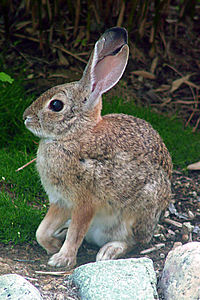- Desert Cottontail
-
Desert Cottontail[1] 
Conservation status Scientific classification Kingdom: Animalia Phylum: Chordata Class: Mammalia Order: Lagomorpha Family: Leporidae Genus: Sylvilagus Species: S. audubonii Binomial name Sylvilagus audubonii
(Baird, 1858)
Desert Cottontail range The Desert Cottontail (Sylvilagus audubonii), also known as Audubon's Cottontail, is a New World cottontail rabbit, a member of the family Leporidae.
The Desert Cottontail is found throughout the western United States from eastern Montana to western Texas, and in northern and central Mexico. Westwards its range extends to central Nevada and southern California and Baja California.[2] It is found at heights of up to 2000 metres. It is particularly associated with the dry near-desert grasslands of the American southwest, though it is also found in less arid habitats such as pinyon-juniper forest.
The Desert Cottontail is quite similar in appearance to the European Rabbit, though its ears are larger and are more often carried erect. It is also much less of a social animal, and makes much less use of burrows. Like all the cottontail rabbits, the Desert Cottontail has a rounded tail with white fur on the underside which is visible as it runs away. It is a light grayish-brown in colour, with almost white fur on the belly. Adults are 33 to 43 cm (13 to 17 in) long and weigh up to 1.5 kg (3.3 lb). The ears are 8 to 10 cm (3.1 to 3.9 in) long, and the hind feet are large, about 7.5 cm (3.0 in) in length). There is little sexual dimorphism, but females tend to be larger than the males, but have much smaller home ranges, about 4,000 m² (1 acre) compared with about 60,000 m² for a male.
The Desert Cottontail is not usually active in the middle of the day, but it can be seen in the early morning or late afternoon. It mainly eats grass, but will eat many other plants, even cacti. It rarely needs to drink, getting its water mostly from the plants it eats or from dew. Like most lagomorphs, it is coprophagic, reingesting and chewing its own feces; this allows more nutrition to be extracted.
Many desert animals prey on cottontails, including birds of prey, mustelids, the Coyote, the Bobcat and humans. Southwestern Native Americans hunted them for meat but also used their fur and hides. The cottontail's normal anti-predator behavior is to run away in evasive zig zags; it can reach speeds of over 30 km/h (19 mph). Against small predators it will defend itself by kicking.
The young are born in a shallow burrow or above ground, but they are helpless when born, and do not leave the nest until they are three weeks old. Where climate and food supply permit, females can produce several litters a year. Unlike the European Rabbit, they do not form social burrow systems, but compared with some other leporids, they are relatively tolerant of other individuals in their vicinity.
References
- ^ Hoffman, Robert S.; Smith, Andrew T. (16 November 2005). "Order Lagomorpha (pp. 185-211". In Wilson, Don E., and Reeder, DeeAnn M., eds. Mammal Species of the World: A Taxonomic and Geographic Reference (3rd ed.). Baltimore: Johns Hopkins University Press, 2 vols. (2142 pp.). pp. 208. ISBN 978-0-8018-8221-0. OCLC 62265494. http://www.bucknell.edu/msw3.
- ^ a b Mexican Association for Conservation and Study of Lagomorphs (AMCELA), Romero Malpica, F.J. & Rangel Cordero, H. (2008). "Sylvilagus audubonii". IUCN Red List of Threatened Species. Version 2009.2. International Union for Conservation of Nature. http://www.iucnredlist.org/apps/redlist/details/41297. Retrieved 01 February 2010.
External links
- "Sylvilagus audubonii". Integrated Taxonomic Information System. http://www.itis.gov/servlet/SingleRpt/SingleRpt?search_topic=TSN&search_value=180122. Retrieved 10 February 2006.
- 1978 issue of Mammalian Species on the Desert Cottontail (PDF)
- North American Mammals page on Desert Cottontail at the Smithsonian Institution
- Desert USA page on Desert Cottontail
Categories:- IUCN Red List least concern species
- Sylvilagus
- North American desert fauna
- Fauna of the Southwestern United States
- Fauna of the California chaparral and woodlands
- Fauna of the Colorado Desert
- Fauna of the Great Basin desert region
- Fauna of the Mojave Desert
- Fauna of Northern Mexico
- Fauna of Mexico
- Mammals of the United States
Wikimedia Foundation. 2010.


